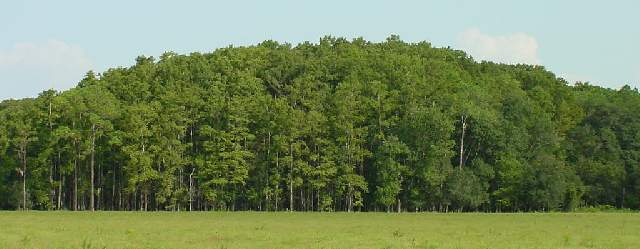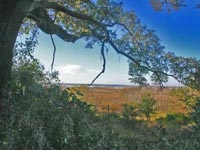Home >>> Local History >> Natural History
Madera's Natural History
One of Florida's most valuable assets is its' natural history. Madera is located near several different ecosystems or natural communities. An ecosystem is a place where living (e.g. animals) and non-living (e.g. water, soil) elements interact.
Each ecosystem is characterized by a particular soil type and plant community. Several different communities can gradually blend together. Some are even dependent on the occurrence of natural fires to persist. Here are a few natural communities you will find around Madera.
For a complete list of Florida's natural communities, visit the Florida Natural Areas Inventory.
 Hardwood
hammocks
Hardwood
hammocks
Pine
flatwoods
Florida's most extensive ecosystem occurs all around the sandy ridge that runs north and south through the center of the state. Individual communities can be interspersed with smaller communities of wetland or cypress domes. Flatwoods can be identified by the level land and the consistent vegetation including: slash pine, saw palmetto, wax myrtle, blackberry, gallberry
Wetlands
"Wetlands" actually encompasses a
few different water ecosystems. All are ecologically important
because of their ability to reduce pollution levels by filtering and
absorbing organic and inorganic chemicals from the water.
Swamps occur along rivers and lakes
and are mixed in with other communities such as pine flatwoods. Swamps
are found in low-lying areas with poorly drained soils
that are flooded part of the year. Plants in this ecosystem bear fruit
at different times than upland plants, providing wildlife with a year-round
food supply. Swamp plants include: black gum, red maple, sweet bay, bald cypress
 Freshwater
marshes are also found in low, flat, poorly drained areas and
are dominated by rooted, herbaceous plants growing in shallow water.
Fire plays an important role in this ecosystem. Without fire, marshes
become replaced by forest plants and trees. Freshwater marsh plants
include: water lilies, pickerelweed, maidencane, sawgrass
Freshwater
marshes are also found in low, flat, poorly drained areas and
are dominated by rooted, herbaceous plants growing in shallow water.
Fire plays an important role in this ecosystem. Without fire, marshes
become replaced by forest plants and trees. Freshwater marsh plants
include: water lilies, pickerelweed, maidencane, sawgrass
 Cypress Domes are forested wetlands
that are dominated by cypress trees. Here, groundcover plants are sparse
due to prolonged water inundation. The term "dome" refers
to the phenomenon that the larger trees grow in the center of the dome,
and the trees get progressively smaller as they grow further from the
center. Cypress trees have developed an important adaptation in response
to the water-logged soils in which they root. The roots produce "knees" that protrude above the soil and water. Although there are many theories
about the function of the knees, many believe they are used for gas
exchange. Cypress dome plants include: pond cypress, red maple, buttonbush, bald cypress, sweetgum
Cypress Domes are forested wetlands
that are dominated by cypress trees. Here, groundcover plants are sparse
due to prolonged water inundation. The term "dome" refers
to the phenomenon that the larger trees grow in the center of the dome,
and the trees get progressively smaller as they grow further from the
center. Cypress trees have developed an important adaptation in response
to the water-logged soils in which they root. The roots produce "knees" that protrude above the soil and water. Although there are many theories
about the function of the knees, many believe they are used for gas
exchange. Cypress dome plants include: pond cypress, red maple, buttonbush, bald cypress, sweetgum
Paynes Prairie
Also known as a "wet prairie," Paynes Prairie encompasses 25 natural communities, including freshwater marsh, pine flatwoods, and mixed deciduous forest. Formed by the dissolution of the underlying limestone, the water levels of the open basin fluctaute drastically between periods of heavy rainfall and drought. For more information about Paynes Prairie, visit Paynes Prairie Preserve State Park or Friends of Paynes Prairie.

